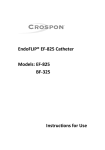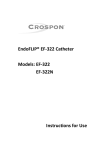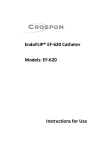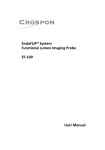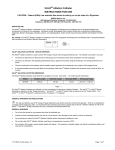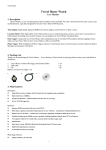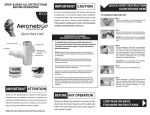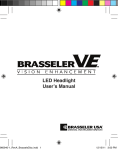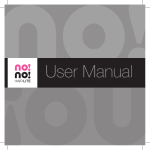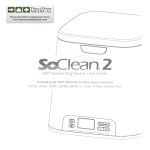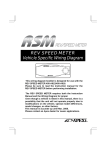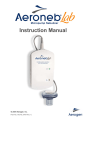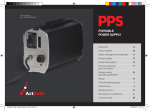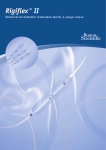Download Model ES-330
Transcript
EsoFLIP® ES-330 Dilation Catheter Model: ES-330 Instructions for Use Table of contents 1. 2. Introduction ........................................................................................ 3 1.1 How it works ................................................................................. 3 1.2 Intended Use ................................................................................. 4 1.3 Contraindications .......................................................................... 4 1.4 Warnings ....................................................................................... 4 Using the catheter ............................................................................... 5 2.1 Installing the catheter assembly ................................................... 5 2.2 Placing the catheter at the GEJ ..................................................... 7 2.3 Disconnecting the catheter ........................................................... 8 Appendix A: Specifications ............................................................................ 9 Copyright © 2014 Crospon Ltd. This document is the sole property of Crospon Ltd. No part of this document may be copied or otherwise reproduced, or stored in any electronic information retrieval system, without the prior consent of Crospon Ltd. EndoFLIP®, EsoFLIP® and FLIP® are registered trademarks of Crospon Ltd. ii EsoFLIP® ES-330 Catheter Instructions for Use, DD-639 Rev A 1. Introduction The EsoFLIP® Balloon Dilation Catheter is designed for use with the EndoFLIP® System, which displays estimates of the diameters at 14 points over a length of 70mm along the balloon. The maximum diameter of 30mm is achieved over a length of 80mm along the balloon. The EndoFLIP® system is used to inflate and deflate the balloon with fluid supplied with the catheter. To monitor balloon pressure, a balloon inflation pressure monitor (not supplied) is also required. 1.1 How it works The ES-330 Catheter has a 30 mm diameter dilation balloon which acts as a functional lumen imaging probe (FLIP) showing dynamic changes in the geometry of the gastroesophageal junction (GEJ) in a real-time image. The catheter connects to an EndoFLIP® System, which injects a conductive solution into the dilation balloon placed in the GEJ. The balloon contains an array of electrodes that measure voltage. As the balloon inflates under user control, the EndoFLIP® System uses these voltages to estimate the diameter at 14 points, 5 mm apart, along the measurement area (Figure 1). Refer to the EndoFLIP® user manual for a further description of the system. Tissue Catheter Balloon inflated with conductive solution Estimated diameter (Dest) measured at each electrode (14 measurements, 5mm apart) Figure 1: EsoFLIP® ES-330 Catheter EsoFLIP® ES-330 Catheter Instructions for Use, DD-639 Rev A 3 1.2 Intended Use The EsoFLIP® Balloon Catheter is used in a clinical setting to dilate the GastroEsophageal Junction for the purpose of treating Achalasia. Note: The ES-330 catheter is to be used only with the EndoFLIP® system. 1.3 Contraindications • • The EsoFLIP® catheter is contraindicated where endoscopy is contraindicated. • The EsoFLIP® catheter is not suitable for diameter measurements smaller than 8mm or greater than 30mm. 1.4 Do not use the EsoFLIP® System on patients with actively-bleeding varices in the esophagus or with active esophageal perforation. Warnings • Do not reuse, reprocess, or re-sterilize. Reuse, reprocessing or re-sterilization can: compromise the structural integrity of the device; impair performance accuracy due to residual fluid in the balloon and degrade the catheter markings. • A balloon inflation pressure monitor, with a measurement range of at least 0 to 5ATM (507kPa), should be connected to the Balloon inflation monitor port during dilations. • • • Do not exceed the maximum inflation pressure of 1.5 ATM (152 kPa). • To ensure proper operation and to minimize the risk of patient injury, do not attempt to add or remove fluid from the supplied pre-filled syringes. Only use the pre-filled syringe supplied with the catheter. Federal law (U.S.) restricts this catheter to sale by, or on the order of, a physician. All catheter components are intended for single patient use only: do not attempt to reuse. Follow all applicable Federal and local regulations for disposal or recycling. Note: Different catheter part numbers are supplied with different solution concentrations. • To avoid damaging the catheter and syringe, store away from sources of heat in specified environmental conditions (see Appendix A: Specifications). • Before using the EndoFLIP® System and catheter on a patient, allow the device to acclimate to conditions of use following transport or storage. • • Set up the catheter so that it does not pose a tripping hazard. • Verify that there are no leaks in the catheter during the pre-use purge cycle described in the EndoFLIP® System user manual. • Replace the catheter if a Dest value remains consistently at a maximum or minimum compared to adjacent Dest values; this can indicate a faulty catheter. 4 During operation, check that the amount of fluid in the syringe matches the amount shown onscreen, and verify that the syringe refills as indicated when the plunger aligns with the arrow on the syringe (indicating that the balloon is empty) before carefully removing the catheter from the patient. EsoFLIP® ES-330 Catheter Instructions for Use, DD-639 Rev A • • Remove the catheter if the patient requires defibrillation. • Maintain continuous observation of the patient and alarms during use to avoid any risks associated excess inflation pressure. Observe the balloon pressure and Dmin at all times during a procedure. • If using a guide-wire to deploy the catheter, ensure the guide-wire is 0.0035” maximum diameter and at least 50cm in length. • Caution: A thorough understanding of the technical principles, clinical applications, and the risks associated with balloon dilation is necessary before using the EsoFLIP ® Balloon Dilation Catheter. The EsoFLIP® Balloon Dilation Catheter should only be used by, or under the supervision of, physicians thoroughly trained in balloon dilation. 2. Refer to the EndoFLIP® user manual for warnings relating to use of the EndoFLIP® System. Using the catheter This section describes how to install and use the EsoFLIP® ES-330 Catheter. 2.1 Installing the catheter assembly Warning: Before use, inspect the catheter assembly from end to end for breakage, occlusions, or debris. Do not use if damage to the parts or packaging is evident. Do not use any part after its expiration date or if the expiry date cannot be verified. 1. Remove the catheter assembly from its packaging; remove the protective sheath from the balloon, and dispose of the sheath. 2. Place the balloon, tip first, into the EndoFLIP® pre-use checkout tube, which holds the balloon in a vertical position (see Figure 2). Catheter with the balloon inside the Preuse checkout tube. Pre-use checkout tube. Figure 2: EsoFLIP® catheter in the pre-use check-out tube. 3. Connect a pressure monitor with a range of at least 0 to 5 ATM to the Balloon Inflation Monitor Port as shown in Figure 3. EsoFLIP® ES-330 Catheter Instructions for Use, DD-639 Rev A 5 Three-way valve supplied with dilation catheter. Figure 3: Pressure monitor connected to monitor balloon inflation pressure 4. Insert the catheter electrical connector into the slot at the front of the unit, with the green dot on the connector aligned with the green dot on the unit. Prepare the catheter for use as described in the EndoFLIP® System user manual. 6 EsoFLIP® ES-330 Catheter Instructions for Use, DD-639 Rev A 2.2 Placing the catheter at the GEJ Warning: Wipe down the catheter prior to use with IPA. 1. Apply a lubricant to the balloon (if desired). Note: do not pre-inflate the balloon. 2. Introduce the catheter orally alongside the endoscope and carefully advance it into the esophagus under direct endoscopic visualization and through the GEJ as far as the stomach so that the proximal end of the balloon sits just below the GEJ. Use the catheter markings as a guide. Warning: Avoid using excessive force during insertion and withdrawal. If the catheter is difficult to advance, remove and retry the insertion. A 0.035” guide-wire may be used to assist insertion by sliding the EsoFLIP® catheter tip over the pre-inserted guide-wire. 3. Inflating the balloon a. Fill the EsoFLIP® balloon to 30ml. b. Slowly pull back until you feel some resistance and the GEJ can be seen at the centre of the measurement area on the screen of the EndoFLIP system. If you cannot retract the catheter, reduce the amount of fluid in the balloon. Maximum Balloon Diameter: 30mm Catheter markings are referenced from center of the balloon, 0 mm = center Balloon working length: Measurement = 70mm Dilation = 80mm. Balloon end to end length including cones: 125mm Guide-wire (0.035”) tip Figure 4: EsoFLIP® Balloon Dilation Catheter assembly Note: The markings on the catheter are referenced from the center of balloon. 4. Secure/hold the catheter once it is properly positioned in the GEJ, to reduce the risk of slippage. 5. Inflate the balloon to dilate the GEJ, continue checking that the balloon is correctly located within the GEJ. Note the Balloon Rated Burst Pressure limit in the Specifications section below. Warning: Do not exceed the maximum inflation pressure of 1.5 ATM (152 kPa). 6. After dilating the GEJ, you may deflate the balloon to assess the GEJ opening diameter post-dilation. EsoFLIP® ES-330 Catheter Instructions for Use, DD-639 Rev A 7 2.3 Disconnecting the catheter 1. Fully deflate the balloon and check that the plunger has stopped at the original volume of the syringe as indicated by an arrow on the syringe (See Figure 5), and the Dest graphic and inflation status both indicate that the balloon is empty. The catheter can then be removed slowly and carefully from the patient. 2. Disconnect the catheter and syringe from the unit. Check the structural integrity of the catheter following removal from the patient. Warning: In the unlikely event that the EndoFLIP® System stops normal operation during a procedure, use the back panel on/off switch to turn the EndoFLIP® system off, remove the syringe from the unit and retract the syringe plunger manually to withdraw fluid from the balloon catheter to the original volume of the syringe as indicated by an arrow on the syringe (Figure 5). The catheter can then be removed slowly and carefully from the patient. Syringe returned to original position: plunger aligns with the arrow. Figure 5: Syringe returned to original position Warning: Single use device, follow all applicable Federal and local regulations for disposal or recycling of the syringe and catheter. 8 EsoFLIP® ES-330 Catheter Instructions for Use, DD-639 Rev A Appendix A: Specifications Operating and storage conditions Operating conditions Temperature 20 to 40 °C Humidity 15 to 95% relative humidity (non-condensing) Atmospheric pressure 700 to 1060 hPa Storage conditions Main label symbols Temperature 0 to 25 °C Humidity 10 to 95% relative humidity (non-condensing) Atmospheric pressure 500 to 1060 hPa Single-use device Storage temperature limits Use-by date Fragile Manufacturer EsoFLIP® ES-330 Catheter Instructions for Use, DD-639 Rev A 9 Batch code Part number Caution, consult accompanying documents CE Mark and Notified Body Number: product complies with requirements of the Medical Device Directive 93/42/EEC Date of Manufacture Rx ONLY Xn 10 Caution: Federal law restricts this device to sale by or on the order of a physician. Box contains quantity ‘n’ catheter(s) EsoFLIP® ES-330 Catheter Instructions for Use, DD-639 Rev A Catheter Specifications Inflated Balloon Diameter 30 mm over an 80 mm length Recommended Pressure to achieve 30 mm balloon diameter 1.5 ATM (152 kPa) Balloon Rated Burst Pressure (RBP) 3 ATM (304 kPa) Maximum Inflate Volume 75ml Maximum Inflate Rate 60ml/min Maximum Deflate Rate 30ml/min Dest Measurement Range 8mm-30mm over a 70 mm length Dest Measurement Accuracy ±1mm over measurement range. Compliance Chart Diameter (mm) Pressure (ATM) Pressure (kPa) 0.5 51 27.10 27.34 27.58 1 101 28.55 28.71 28.86 1.5 152 29.55 29.73 29.90 2 203 30.38 30.57 30.76 2.5 253 31.09 31.28 31.47 3 304 31.56 31.77 31.98 Min. EsoFLIP® ES-330 Catheter Instructions for Use, DD-639 Rev A Average Max. 11 Manufacturer information Crospon Ltd. Galway Business Park Dangan Galway Ireland Europe: Phone: +353-91-519880 Fax: +353-91-519889 email: [email protected] US: Phone: 1-855-CROSPON Fax: 760-406-5644 email: [email protected] 12 EsoFLIP® ES-330 Catheter Instructions for Use, DD-639 Rev A












